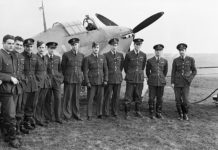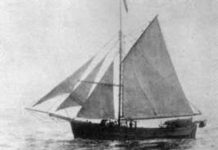
On 17 May 1689, England and France ended several years of uneasy peace by officially declaring war. Securing control of Hudson Bay – and thus the northern fur trade – was a critical objective of both the European powers. The owners of the Hudson’s Bay Company (HBC) were eager to regain their trading posts on the Bay that had been captured in 1686 by the Canadian-born French commander Pierre Le Moyne d’Iberville. These men had excellent connections within the English government, which they utilized to mobilize military support for their cause (Iberville’s actions at the Bay were among the provocations listed in England’s declaration of war).
Between 1689 and 1697, control of the Bay changed hands several times. In 1690 Iberville, who had been appointed France’s Commander-in-Chief of the Bay, captured the HBC post on the Severn River along with a rich haul of beaver pelts, but was unable to take the company’s main post at York Factory. The English retaliated in 1693, when a force led by James Knight recaptured Albany Fort and thirty thousand beaver pelts: the Canadian defenders were forced to destroy their other two posts on James Bay to prevent Knight from seizing them as well.
Then, in 1694, Iberville returned to York Factory. HBC’s most important post was defended at the time by a small group of fur traders with no military training, who were quite happy to surrender after Iberville’s gunners lobbed a few cannon balls into the fort. Iberville renamed the site Fort Bourbon, and was soon headed back to France with yet another load of captured pelts. Ten months later, during his absence, the fort was easily retaken by the English, effectively eliminating the French presence on the Bay.
This situation continued until 1697, when England and France opened peace negotiations. Both countries wished to secure control of Hudson Bay before these negotiations concluded so, that summer, both dispatched strong naval fleets to the Bay to settle the matter. The French fleet was commanded by Iberville, with orders to recapture York Factory and then fortify it with a garrison of one hundred soldiers.
Naval Battle on the Bay
Iberville’s fleet was comprised of six ships. Upon reaching Hudson Strait, all six became trapped in the ice floes that still clogged the passage, and two were eventually lost. After three weeks Iberville’s flagship, the 44-gun Pelican, was freed and proceeded to Hudson Bay ahead of the remainder of the fleet, anchoring off York Factory on 3 September.
The following morning, Iberville sighted three ships on the horizon. Believing them to be his stragglers, he weighed anchor and sailed out to meet them. It was only when the flotilla drew near that he realized it was the English naval fleet: two heavily-armed HBC freighters, the Dering and the Hudson Bay, and the Royal Navy frigate Hampshire. Between them, the enemy ships carried 118 guns. Outnumbered and outgunned, Iberville promptly attacked.
In the ensuing two-hour battle, the Pelican was bombarded relentlessly: much of her rigging was shredded, her superstructure was reduced to a mass of splintered wood, a section of her prow was blasted away, and many of her crewmen were killed or wounded. Still, Iberville pressed the attack. Keeping to the windward side of the enemy ships, and utilizing his superior knowledge of the Bay’s treacherous waters, he managed to maintain headway.
With the Pelican and the Hampshire sailing side-by-side, guns blazing, the English commander gallantly observed the niceties of warfare in that age by toasting his adversary’s courage with a glass of claret. Iberville reciprocated, and then fired a full broadside into the Hampshire, holing her at the waterline. The frigate staggered, then struck a shoal and sank with the loss of all hands. Shortly thereafter, the Hudson Bay surrendered and the Dering fled.
As the members of a prize crew from the Pelican were boarding the Hudson Bay, a fierce storm blew in from the open water. The Hudson Bay was driven ashore, but the badly-damaged Pelican foundered on a sandbar. Her lifeboats had been shot away during the battle, so survivors were forced to swim several miles to shore, towing their wounded shipmates on makeshift rafts. Once ashore, Iberville and his men comforted themselves with weak seaweed tea until the rest of the French fleet arrived the following day.
The Capture of York Factory
Iberville now had the men and ordnance he needed to take York Factory, but cannon fire from the fort prevented them from being brought ashore. This problem was solved by a daring ruse. Iberville led several crewmen from the Pelican in a feint to the walls of the fort, drawing the fire of the defenders long enough for the French troops, cannons and mortars to land.
Once the guns were in place, a barrage of artillary fire rained down on York Factory, but the garrison refused to surrender. Finally, Iberville threatened to unleash an assault in which no quarter would be given to the HBC men. Capitulation quickly followed: the following day, the Englishmen marched out of the relative comfort of their fort to confront the prospect of spending the approaching winter in the wilderness by the Bay.
Aftermath
Iberville remained at Hudson Bay until 1 November, overseeing the repairing and strengthening of York Factory’s defenses. He then sailed out of the Bay for the last time, bound for France, his victory complete. The French had achieved domination of Hudson Bay and the fur trade in the surrounding territory, a position they would enjoy for the next sixteen years.
Sources:
- Costain, Thomas B. The White and the Gold: The French Regime in Canada. Doubleday & Company, Inc. Garden City, New York, 1954.
- Eccles, William J. Canada under Louis XIV. McClelland & Stewart Limited, Toronto, 1964.
- Newman, Peter C. Company of Adventurers. Penguin Books Canada Ltd., 1985.






